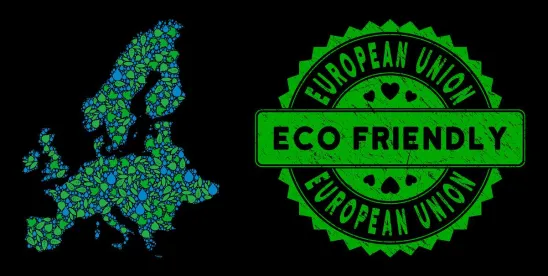Background
The European Commission has taken another step towards meeting its green transition goals by adopting a new framework for implementing sustainability requirements for a wide range of products. Under the Ecodesign for Sustainable Products Regulation (ESPR), which enters into force on July 18, 2024, the European Commission is replacing the Ecodesign Directive for Energy-Related Products (2009) with a more comprehensive approach to regulating product design and information sharing and strengthened market surveillance. The ESPR applies to physical goods placed on the market, subject to a few exclusions, and will be implemented through product-specific and “horizontal” (covering multiple product groups that display similarities allowing a common regulatory approach) regulations in all EU countries.
The Commission proposed the new regulation on March 30, 2022. The Council adopted its general approach on May 23, 2023, and reached a provisional agreement with the Parliament on December 4, 2023. Following the Council’s approval on May 27, 2024, the legislative act has now been adopted. It will apply in July of 2026, 24 months after the entry into force.
The ESPR provides a framework for new rules to:
- set environmental sustainability requirements for almost all goods placed on the EU market;
- establish a digital product passport; and
- restrict or prohibit the destruction of certain unsold consumer goods.
Overview of Types of Requirements
The requirements range from information requirements concerning the duration of software compatibility of electronic devices, to reporting obligations on handling unsold durable goods. The new ecodesign requirements aim to improve the environmental profile of products, addressing everything from product durability to energy and resource efficiency, to restrictions on the use of hazardous chemicals, and end-of-life management. Circular economy principles are also central, encouraging reusability, recyclability, and remanufacturing.
Performance vs. Informational Requirements
Performance requirements focus on ensuring that products meet specific parameters or performance measures (e.g., energy efficiency), while informational requirements ensure that distributors, retailers, ultimate end users, as well as the companies that handle repair, recycling, and disposal, understand each product’s environmental profile. Performance requirements impact product design, while information requirements may influence purchasing decisions as well as how products are handled once sold by the manufacturer.
Performance requirements should result in the removal of poorly performing products from the market and a gradual transition to the best-performing ones, contributing to the environmental sustainability objectives set by the ESPR.
Information requirements should relate to specific product parameters, such as a product’s environmental footprint, carbon footprint, and durability.
- Delegated acts should specify methods for making the required information easily accessible, such as free-access websites, digital product passports, or product labels.
- The ESPR envisages that information requirements relating to the repairability and durability of products will contribute to sustainable consumption.
- The ESPR encourages the development of repairability scores with clear language and harmonized methodologies.
- Additionally, the ESPR encourages informational requirements about harmful substances to ensure adequate tracking throughout the product’s life cycle.
- Depending on the situation, these information requirements can complement or replace performance requirements, but the Commission must justify its decision when opting for information requirements only.
Once the Commission adopts a delegated act that sets ecodesign requirements for a product group, Member States should no longer impose national performance or information requirements based on the same product parameters covered by that act. The goal is to ensure consistent, harmonized functioning of the internal market.
Categories of Regulation
Right to Repair: The requirements should be designed to improve product durability, reliability, repairability, upgradability, reusability, and possibilities for refurbishment and maintenance. One measure includes a repairability score.
Recycling Content: The recycling content should include the identification of chemicals that could hinder a product’s reuse and recycling. The framework also includes a requirement for minimum quantities of recycled content or performance conditions. This would make it mandatory for contracting authorities and contracting entities to give the recycled content of the products in question a minimum weight.
Material Restrictions: The Commission encourages restricting substances that negatively affect a product’s sustainability, but cautions against restrictions based primarily on chemical safety where union law on these chemicals already provides for restricting substances or mixtures related to safety or risk.
Energy Efficiency: The framework outlined in the ESPR focuses on reducing products’ energy consumption by encouraging the setting of efficiency standards to lower the overall energy footprint and reduce vulnerability to energy price fluctuations.
Digital Product Passports
The Digital Product Passport (DPP) is a new tool designed to enhance the traceability of a product throughout its entire value chain. The DPP is intended to improve customers’ access to information regarding the environmental profile of products, enabling them to make informed choices and facilitating repair and recycling. It also allows various value chain actors to access, introduce, or update relevant data. The framework anticipates that the DPP will be designed to be user-friendly, with accurate and up-to-date data, linked to a unique product identifier. It can be complemented by non-digital forms of information transmission, such as product manuals or labels, and used to provide information concerning the relevant product group under other Union laws.
The design and implementation of the DPP will consider the nature of the product and its market. It will allow differentiated access to its data, depending on the type of data and the typology of stakeholders, thereby protecting intellectual property rights and optimizing data access. The DPP should be specific to the item, batch, or product model, depending on factors such as the complexity of the value chain and the size, nature, or impacts of the products considered.
Considerable work remains before DPP requirements come into force, including:
- Rules and requirements DPP service providers must follow, including a certification scheme to verify such requirements (via delegated act).
- Procedures to issue and verify the digital credentials of economic operators and other relevant actors that shall have access rights to DPP information (via implementing act).
- Rules and procedures related to unique identifiers and data carriers’ lifecycle management (via delegated acts)
- Design and set up the DPP registry.
- Design and set up the DPP web portal.
- Definition of standards
Product-specific (or horizontal) DPP requirements will be set out in separate delegated acts.
Substances of Concern
Products containing substances of concern will be regulated to meet heightened information-sharing requirements and lifecycle tracking. The information required in the regulations shall include:
- At least the name or numerical code of the substances of concern present in the product;
- The location of the substances of concern within the product;
- The concentration, maximum concentration or concentration range of the substances of concern, at the level of the product, its relevant components, or spare parts;
- Relevant instructions for the safe use of the product; and
- Information relevant for disassembly, preparation for reuse, reuse, recycling and the environmentally sound management of the product at end-of-life.
Restrictions on the use of certain substances of concern are possible, including outright prohibitions where warranted.
Destruction of Products
Economic operators will be required to take measures to prevent the destruction of unsold consumer products and disclose measures taken and planned to prevent product destruction. If they discard unsold products, they must disclose the number and weight of discarded products per year, differentiated by product type or category, the reasons for discarding products, and the proportion of discarded products delivered for reuse, recycling, recovery, or disposal.
The Commission will publish consolidated information on the destruction of unsold consumer products, including the prevalence of destruction of specific product groups per year and the comparative environmental impacts of product destruction. This information will be based on the disclosures made by economic operators.
While such regulations will primarily be imposed via product-specific designated acts, ESPR imposes more immediate reporting requirements (in 2025) and disposal prohibitions (in 2026) on the clothing apparel and footwear product categories.
Obligations for Economic Operators
Before placing a product on the market, economic operators must ensure that the appropriate conformity assessment procedure has been carried out by the manufacturer and that the manufacturer has prepared the necessary technical documentation.
Distributors have an obligation to not make the product available on the market until it has been brought into conformity or the manufacturer complies. They must also promptly inform the market surveillance authorities of the Member States where they made the product available about any suspected non-compliance and any corrective action taken.
Dealers are required to ensure that their customers and potential customers have access to any relevant information accompanying products and that the digital product passport is easily accessible for customers.
Penalties and Enforcement
Enforcement efforts under the Ecodesign Directive were generally considered inconsistent, opaque, and insufficient to deter non-compliance. To ensure a higher level of compliance with ecodesign requirements, penalties will be imposed on economic operators who place non-compliant products on the market. Member States must establish rules on these penalties, which should be effective, proportionate, and dissuasive, including fines and time-limited exclusion from public procurement procedures. The criteria for determining penalties should consider the nature, gravity, and duration of the infringement, the financial situation of the responsible party, and the economic benefits derived from the infringement.
In addition, consumers who have suffered damage due to non-compliance of a product with ecodesign requirements have the right to claim compensation from the product’s manufacturer, importer, authorized representative, or fulfillment service provider. This right is in addition to other remedies available under Union law, such as those against the seller for lack of conformity of the goods sold. Member States are also allowed to maintain or introduce additional consumer rights, such as the repair or replacement of products infringing ecodesign requirements.
The ESPR will also further the use of self-regulation measures, attempting to improve upon the Voluntary Agreements developed for some product categories under the Ecodesign Directive, such as imaging equipment. If manufacturers representing a sufficiently representative share of the market for a product can agree on acceptable criteria, that product can be covered by a self-regulation measure, the oversight of which will include a detailed, transparent, and objective monitoring plan with clearly identified responsibilities for industry and independent inspectors. Rules on information to be reported by signatories, testing, and inspections are included, with provisions for removing a signatory that has not undertaken sufficient corrective action within three months.
Transition from ErP and Likely Early Product Targets
The ESPR repeals the Ecodesign Directive, (2009/125/EC), which previously set out the European Union’s ecological requirements for Energy-related Products (ErPs). ErPs are any products that impact energy consumption during use.
The ESPR intends to extend the approach of the Ecodesign Directive to other product groups to systematically address key aspects for increasing the environmental sustainability of products with binding requirements. Based on the process followed for prioritization under the Ecodesign Directive, the Commission should adopt a working plan that covers at least three years, which includes both a list of product groups for which it intends to adopt delegated acts, as well as a list of the product aspects for which it intends to adopt delegated acts of horizontal application.
The Commission’s first working plan should prioritize iron, steel, aluminum, textiles, furniture, tires, detergents, paints, lubricants, chemicals, information and communication technology products and other electronics, and energy-related products for which ecodesign requirements either exist pursuant to the Ecodesign Directive or will be reviewed under this ESPR.
The ESPR acknowledges the preparatory work made under the Ecodesign Directive for certain ErPs and requires that transitional rules allow implementing measures for those products by December 31, 2026. Additionally, necessary amendments addressing technical issues that ensure the proper functioning of implementing measures adopted under Article 15 of the Ecodesign Directive should be adopted on December 31, 2030.





 />i
/>i
